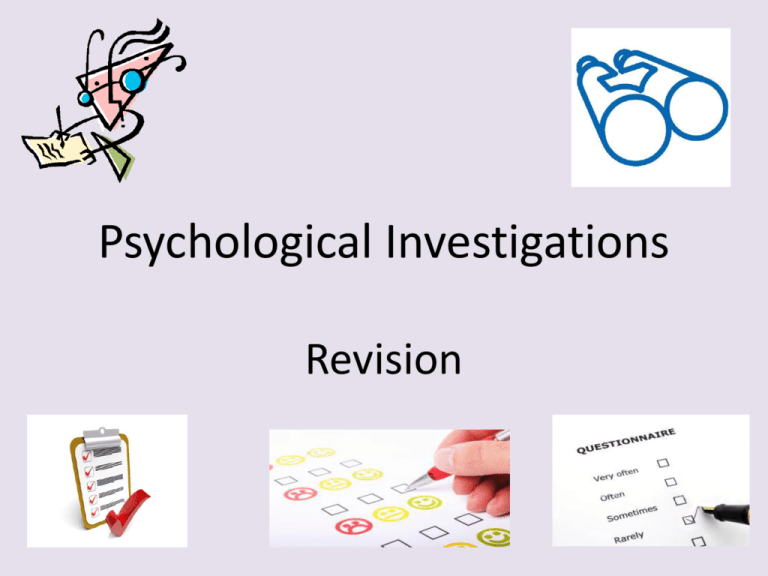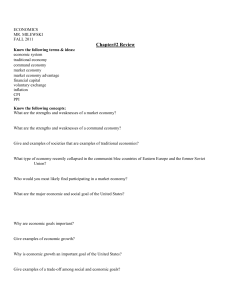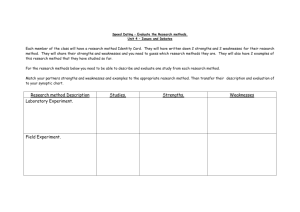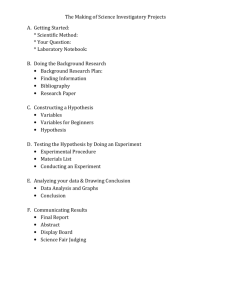Psychological Investigations
advertisement

Psychological Investigations Revision Plan for today • Recap quiz self-reports, observations, correlations and experiments. • Recap of key points for self-reports, observations, correlations and experiments. • Psychological Investigations Articulate. • Practice exam paper. • Psychological Investigations Bingo RECAP QUIZ PSYCHOLOGICAL INVESTIGATIONS Observations, Self-reports, Correlations & Experiments 1) An experiment where the independent variable is not manipulated by the experimenter. A) Quasi experiment B) Field experiment C) Controlled observation D) Lab experiment 2) When the two groups / conditions in an experiment consist of the same individuals. A) Independent measures design B) Repeated measures design C) Matched pairs design 3) A statement to be tested which predicts that there will be a relationship between two variables. A) Correlational hypothesis B) Null hypothesis C) Experimental hypothesis D) Aim 4) High values of one variable are associated with low values of the other. A) Positive correlations B) Negative correlation C) No correlation 5) Comparing your questionnaire to a well established one is a way to ensure A) B) C) D) Internal reliability External validity Concurrent validity Predictive validity 6) A type of observational study where the observer is also a participant in the activity being studied. A) Naturalistic observation B) Covert observation C) Participant observation 7) Every member of the target population has an equal chance of being chosen to participant in the study. A) Volunteer sample B) Random sample C) Opportunity sample D) Self-selected sample 8) Refers to how consistent a measuring device is. A) Reliability B) Validity C) Ecological validity D) Reductionism 9) A study carried out over a very short period of time such as hours and days. A) Snap-shot study B) Longitudinal study C) Observational study D) Case study 10) Predicts a difference OR correlation between two variables but not the direction A) One-tailed hypothesis B) Two-tailed hypothesis C) Null hypothesis 11) Which of the following is not a type of observation? A) B) C) D) Controlled observation Participant Field Naturalistic 12) Which type of questions would you not want in your questionnaire? A) B) C) D) Open questions Ambiguous questions Closed questions Likert scale questions PSYCHOLOGICAL INVESTIGATIONS The Exam • The exam is 1 hour long and you will have to answer three questions. • This unit is 30% of your total AS psychology paper marked out of 60. • Although you will have to learn four sections for this paper, you will only be asked questions on three of the sections. You may be asked questions about: Experiments Correlations Observations Self-Reports •the piece of research including strengths and weaknesses. •the data produced by the research. •to design your own research •the strengths and weaknesses of this proposed research. Learning objectives for self-reports • Describe strengths and weaknesses of using questionnaires and interviews. • Identify examples of closed and open questions and discuss the type of data they collect. • Describe types of validity and reliability. Questionnaires Questionnaires can be thought of as a written interview. They can be carried out face to face, over the phone or by post. Strengths • Quick, easy and cheap way to gather information from a large number of people. • Anonymity may increase honesty. • Reduces interviewer bias. • • • • • • Weaknesses Leading questions Ambiguous questions Socially desirable answering/lying. Low response rate. Possibly unrepresentative sample. Too long = lose interest. Types of question Open questions Closed questions Better represents participants true feelings (higher validity). Obtains rich and detailed data. More realistic (higher ecological validity). • Difficult and time consuming to analyse. • Harder to compare responses between participants. Easy to score, compare responses and display on a graph. • Participants may be forced to respond in a particular way. • Acquiescence Response Set (ARS) • Does not obtain rich data. Likert scales Strengths Weaknesses Gives more than a yes or no – shows strength of opinion. Produces quantitative data which is easy to analyse. • People tend to respond towards the middle of the questionnaire (look less extreme). • Socially desirable answers • No depth to data produced. Interview Unstructured (Informal chat) Structured (Pre-determined Qs) Detailed information about opinions can be gathered. Encourages openness and flexibility. Standardised questions (replication) Can be fairly quickly and easily applied to a large and representative number of people. • Difficult to analyse. • Time-consuming. • Interviewer effects. • Information gathered depends on quality of questions (can’t be changed). • Lots of pre planning required. Reliability and Validity • Internal reliability – how consistent are participants answers across similar questions? • External reliability – does the test give consistent results on different days for same participants? • Concurrent validity – comparing your questionnaire to an already well established on to check validity. • Predictive validity – are test results a good predictor of future performance? Learning objectives for observations • Understand the differences between the three types of observation and be able to evaluate each. • Understand the differences between the three sampling methods and be able to evaluate each. • Define observer bias and inter-rater reliability. Types of observation 1) Naturalistic Observing and recording the behaviour of people or animals in their natural surroundings i.e. children in playground. 2) Controlled Takes place in a controlled environment which has been manipulated by the experimenter i.e. Bandura et al (1961). 3) Participant Observer takes an active part in the situation under observation usually without the knowledge of the participants i.e. Rosenhan (1973). Naturalistic observation Strengths • High ecological validity • Can be used in situations where an experiment would be unethical. • Can be used to generate ideas which can then be tested experimentally. Weaknesses • Lack of control over variables makes replication difficult. • Cannot infer cause and effect (variables have not been manipulated). • Observer bias Controlled observation Strengths Weaknesses • More control = easier replication. • Lower ecological validity • Easier to use video cameras than in a naturalistic setting. • May cause other ethical issues i.e. cause discomfort, deception and invasion of privacy. • Usually avoids ethical issues • Risk of demand characteristics. Participant observation Strengths • Allows an in-depth and detailed understanding of the situation that non-participant observations cannot provide. Weaknesses • Ethics - privacy/confidentiality. • The participant observer may influence the behaviour under study. • Observer bias • High ecological validity. • More difficult for observer to make notes (memory issues). • It could become dangerous (if cover is blown) Sampling methods: Time sampling Description: Observations made at regular intervals i.e. every 5 minutes. Strength A large number of participants can be observed at once. Weakness Some behaviours may be missed so the observation is not representative. Sampling Methods: Event sampling Description: A list of behaviours drawn up and a frequency count kept. Strength Behaviours are recorded as they occur. Weakness If lots of behaviours occur at once, it may be difficult for observers to record it all. Sampling Methods: Point sampling Description: Continuous observation of just one participants behaviour. Strength Lots of data gathered. Weakness The data gathered is only relevant to one person so cannot be generalised. Observer bias and Inter-rater reliability Observer bias Inter-rater reliability Each individual may make different interpretations during observations or record behaviours differently Measure of agreement between two or more observers. To reduce …. To improve …. 1) Try to have a clear idea of what they are looking for by clearly defining the categories (coding scheme) 2) Using more than one observer and checking the inter-rater reliability. 1) Observers need to clearly operationalise the behaviours under observation. 2) Could perform a pilot study and carry out a correlation to see if there is good consistency between them. Learning objectives for correlations • Be able to define a positive and a negative correlation and give an example of each. • Be able to recognise and write a one tailed correlational hypothesis, a two tailed correlational hypothesis and a null hypothesis. • Be able to identify variables and operationalise variables. • Be able to sketch and label a scattergraph. • Be able to describe strengths and weaknesses of correlations. Defining a correlation • A correlation is a relationship between two variables. • We don’t look for differences between variables. • We don’t look at independent variables and dependent variables, we look at covariables. • CORRELATION DOES NOT MEAN CAUSATION!!! • There are three types of correlation that we can find: –Positive correlations –Negative correlations –No correlation Positive Correlation • A positive correlation occurs when as one variable increases, the other variable also increases. E.G Temperature increases Sales of ice creams increase Negative Correlation • A negative correlation occurs when as one variable increases, the other variable decreases. E.G A chicken gets older It lays fewer eggs Writing hypotheses for correlations: One and two-tailed These are broadly written in the same way as experimental hypotheses, except we are predicting a relationship not a difference. • A two-tailed research hypothesis could be, “ there will be a significant correlation between the achievement in AS Psychology and attendance in Psychology classes”. • A one-tailed research hypothesis could be, ‘there will be a significant positive/negative correlation between the achievement in AS Psychology and attendance in Psychology classes”. Writing hypotheses for correlations: Null • A null hypothesis could be - “ there will be no significant correlation between the achievement in AS Psychology and attendance in Psychology classes”. Operationalising variables What does operationalise mean? How we are going to measure a variable. E.G 1 Variable 1 Intelligence Variable 2 Happiness E.G 2 Variable 1 Tiredness Variable 2 Memory Correlations Advantages Could suggest ideas for an experiment which could investigate cause and effect. Can be used to look at a relationship which is too unethical to conduct an experiment for e.g. smoking and lung cancer. Disadvantages • We can see relationships between variables but we cannot infer cause and effect. • Cannot be used to make prediction Learning objectives for experiments • Identify and give strengths and weaknesses of each type of experiment. • Identify and give strengths and weaknesses of each experimental design. • Work out and express descriptive data. Types - Lab experiments STRENGTHS • High levels of control • Can establish cause and effect relationship between IV and DV (as long as extraneous variables had been eliminated). • Easier to replicate. • Less expensive and time consuming that other methods. WEAKNESSES • Demand characteristics/social desirability. • Experimenter bias. • Low ecological validity. • Ethics (to avoid D.Cs = deception, no informed consent). Types - Field experiments STRENGTHS • High ecological validity. • Still possible to establish cause and effect between IV and DV. WEAKNESSES • Low control over extraneous variables. • Covert observations = ethical issues. Types - Quasi experiments STRENGTHS WEAKNESSES • Inexpensive (do not • Harder to establish causal relationships need to manipulate because I.V is not being IV). directly manipulated. • Can study unusual • Ethical concerns over variables which using participants couldn’t be without consent. manipulated i.e. split brains. Design – Repeated measures Description: Same participants in each condition. Strengths Weaknesses • Fewest participants needed. • Participants characteristics will be the same across conditions. • Order effects • Demand characteristics • Drop out Design – Independent Measures Description: Different participants in each condition. Strengths Weaknesses • Quick and easy to • Lots of participants required. run • Participant variables • No order effects or i.e. intelligence may bias bias results. Design – Matched Pairs Description: Different participants in each condition matched for certain characteristics. Strengths Weaknesses • No order effects. • Reduces participant variables. • Requires lots of participants to begin. • If one participant drops out so must the other. • Expensive and time consuming. Descriptive statistics Measures of central tendency 1) Mean = average. Add all entries and divide by number of entries (Can be misleading if there are extremes). 2) Median = middle. Put all numbers in rank order and find middle (Not all scores are taken into account). 3) Mode = most common. Put all numbers in rank order and identify the most frequently occurring number (Used less freq as they tell us nothing about other numbers in the sample, may not be central). Descriptive statistics Measures of spread Range = difference between largest and smallest numbers in a data set. Psychological Investigations Articulate • In groups of 3 • Write 25 key terms from psychological investigations on a piece of paper. • Each team will take it in turns for one member to describe the key terms to their team mates who have to guess which key term they are describing. • RULES = You can’t say the words written on the card, you can’t say sounds like and you can’t say begins with. • Each player can have one pass. TIMER http://www.classtools.net/education-games-php/timer Past exam paper practice June 2009 Self report Experiment Correlation Self-report – Section A 1) A – Clear and appropriate (2) X 2 = (4) B – Clear, evaluation (strength and weakness) and contextualised (4). 2) A – Refer to the target population and suggest one technique to randomly sample (2). B – Clear, 2 + evaluation points about random sampling, contextualised (4). Self-report 3) A – Reference to it being expressed numerically (2). B – One strength and one weakness BOTH contextualised (4). Experiment 4) Description of a way to measure memory that is clear and replicable (6) and an evaluation with reference to more than one evaluation issue (4) =(10) 5) Clear definition of Independent measures (2) and of repeated measures (2) = (4) Experiment 6) Clear and detailed explanation of a strength which is contextualised (3) and clear and detailed explanation of a weakness which is contextualised (3) = (6) Correlation 7) Clearly stated null hypothesis with reference to both of the measured variables (4) 8) A – Appropriate and accurate scattergraph (1) with clear labelling and scales on both axes (3) = (4) B – A clear conclusion which can be clearly derived from the scattergraph (2) X 2 = (4) Correlation 9) Clearly explained strength and contextualised (3) and clearly explained weakness and contextualised (3) = (6) 10) Clear explanation of a negative correlation (2) PSYCHOLOGICAL INVESTIGATIONS BINGO Pick 3 terms from each list • Null hypothesis • One-tailed hypothesis • Two-tailed hypothesis • Independent variable • Dependent variable • Extraneous variable • Qualitative • Quantitative • Volunteer sample • Opportunity sample • • • • • • • • • • Likert Internal reliability External reliability Concurrent validity Predictive validity Controlled Time sampling Point sampling Observer bias Inter-rater reliability • Positive correlation • Negative correlation • Operationalising • Scattergram • Causation • Quasi experiment • Independent measures • Mixed pairs • Median • Mode





